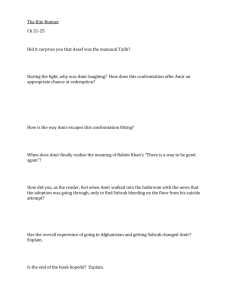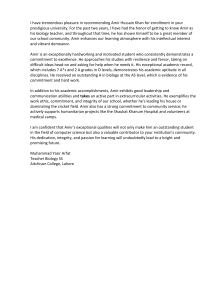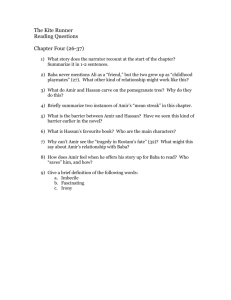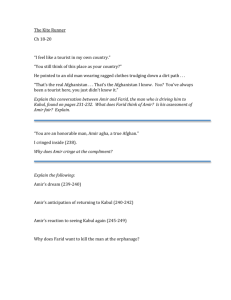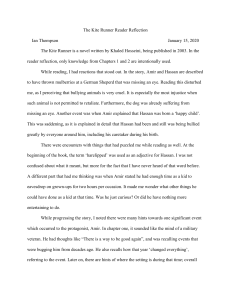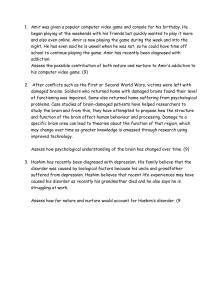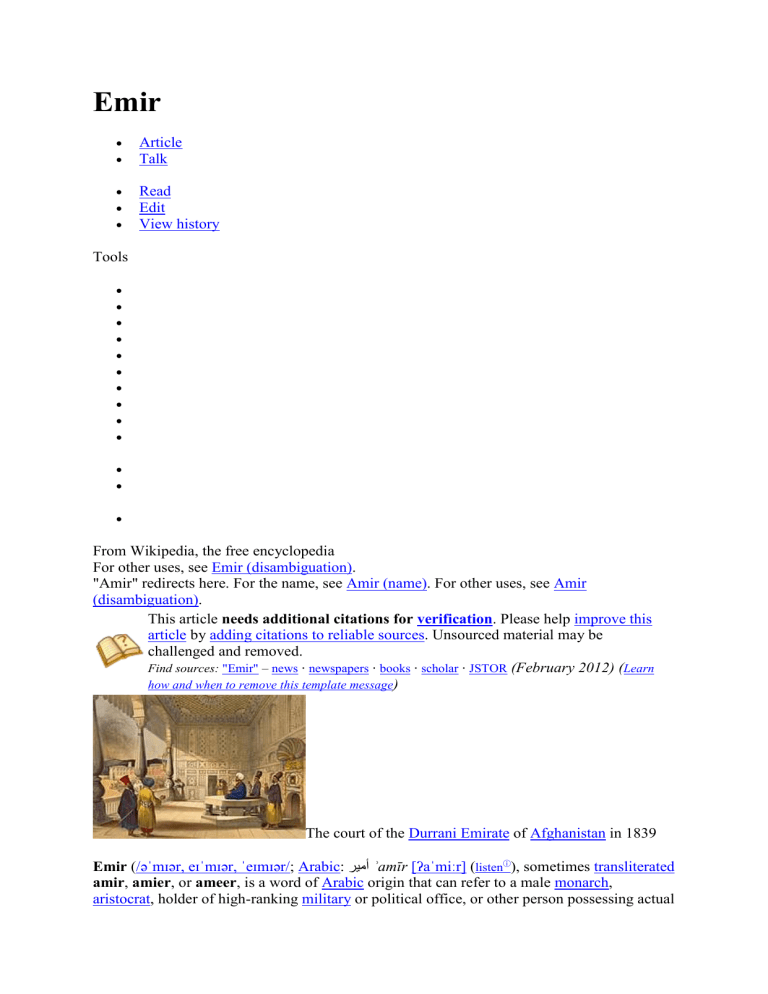
Emir Article Talk Read Edit View history Tools From Wikipedia, the free encyclopedia For other uses, see Emir (disambiguation). "Amir" redirects here. For the name, see Amir (name). For other uses, see Amir (disambiguation). This article needs additional citations for verification. Please help improve this article by adding citations to reliable sources. Unsourced material may be challenged and removed. Find sources: "Emir" – news · newspapers · books · scholar · JSTOR (February 2012) (Learn how and when to remove this template message) The court of the Durrani Emirate of Afghanistan in 1839 Emir (/əˈmɪər, eɪˈmɪər, ˈeɪmɪər/; Arabic: أميرʾamīr [ʔaˈmiːr] (listenⓘ), sometimes transliterated amir, amier, or ameer, is a word of Arabic origin that can refer to a male monarch, aristocrat, holder of high-ranking military or political office, or other person possessing actual or ceremonial authority. The title has a long history of use in the Arab World, East Africa, West Africa, Central Asia, and the Indian subcontinent. In the modern era, when used as a formal monarchical title, it is roughly synonymous with "prince", applicable both to a son of a hereditary monarch, and to a reigning monarch of a sovereign principality, namely an emirate. The feminine form is emira ( أميرةʾamīrah), a cognate for "princess". Prior to its use as a monarchical title, the term "emir" was historically used to denote a "commander", "general", or "leader" (for example, Amir al-Mu'min). In contemporary usage, "emir" is also sometimes used as either an honorary or formal title for the head of an Islamic, or Arab (regardless of religion) organisation or movement. Qatar and Kuwait are the only independent countries which retain the title "emir" for their monarchs. In recent years, the title has been gradually replaced by "king" by contemporary hereditary rulers who wish to emphasize their secular authority under the rule of law. A notable example is Bahrain, whose monarch changed his title from emir to king in 2002.[1] Origins Amir, meaning "lord" or "commander-in-chief", is derived from the Arabic root a-m-r, "command". Originally simply meaning "commander", it came to be used as a title of leaders, governors, or rulers of smaller states. In modern Arabic the word is analogous to the title "Prince". The word entered English in 1593, from the French émir.[2] It was one of the titles or names of the Islamic prophet Muhammad.[citation needed] Princely, ministerial and noble titles Emir of Kano, Sanusi Lamido Sanusi Mohammed Alim Khan, Emir of Bukhara, taken in 1911 by Sergey Prokudin-Gorsky The monarchs of Qatar and Kuwait are currently titled emir.[3][4][5] All members of the House of Saud have the title of emir (prince).[6][7][8] The caliphs first used the title Amir al-Muminin or "Commander of the Faithful", stressing their leadership over the Islamic empire, especially over the militia. The title has been assumed by various other Muslim rulers, including sultans and emirs. For Shia Muslims, they still give this title to the Caliph Ali as Amir al-Muminin. The Abbasid (in theory still universal) Caliph Al-Radi created the post of Amir alUmara ("Amir of the Amirs") for Ibn Raik; the title was used in various Islamic monarchies; see below for military use. In Iraq, the direct descendants of previous Emirs from the largest tribes who ruled the kingdoms before modern statehood, use the title of Sheikh or Prince as the progeny of royalty.[9][10] Formerly in Lebanon, the ruling emir formally used the style al-Amir al-Hakim, specifying it was still the ruler's title. The title was held by Druze and Christians as well.[citation needed] The word emir is also used less formally for leaders in certain contexts. For example, the leader of a group of pilgrims to Mecca is called an emir hadji, a title sometimes used by ruling princes (as a mark of Muslim piety) which is sometimes awarded in their name. Where an adjectival form is necessary, "emiral" suffices.[citation needed] Amirzade, the son (hence the Persian patronymic suffix -zade) of a prince, hence the Persian princely title mirza. The traditional rulers of the predominantly Muslim northern regions of Nigeria are known as emirs, while the titular sovereign of their now defunct empire is formally styled as the Sultan of Sokoto, Amir-al-Muminin (or Sarkin Musulmi in the Hausa language).[citation needed] The temporal leader of the Yazidi people is known as an emir or prince.[citation needed] Afghanistan under the government of the Taliban is officially an emirate, with the leader of the Taliban bearing the title Amir al-Mu'minin. Amīr al-Baḥr (أمير البحر, "commander of the sea") is considered to be the etymological origin of the English admiral, the French amiral and similar terms in other European languages. Military ranks and titles See also: Amir (Iranian Army) From the start, emir has been a military title. In the 9th century the term was used to denote a ruler of a state i.e. Italy's Emirate of Sicily. In certain decimally-organized Muslim armies, Amir was an officer rank. For example, in Mughal India, the Amirs commanded 1000 horsemen (divided into ten units, each under a sipah salar), ten of them under one malik. In the imperial army of Qajar Persia: Amir-i-Nuyan Amir Panj, "Commander of 5,000" Amir-i-Tuman, "Commander of 10,000" The following posts referred to "amir" under medieval Muslim states include: Amir al-umara, "Amir of Amirs" (cfr. supra) or 'Commander of Commanders' Amir al-hajj, "Commander of the Hajj [caravan]" Amir al-ʿarab, "Commander of the Arabs [Bedouin tribes]" In the former Kingdom of Afghanistan, Amir-i-Kabir was a title meaning "great prince" or "great commander". Muhammad Amin Bughra, Nur Ahmad Jan Bughra, and Abdullah Bughra declared themselves emirs of the First East Turkestan Republic. Other uses Amir is a masculine name in the Persian language and a prefix name for many masculine names such as Amir Ali, Amir Abbas. Amir-i-Iel designates the head of an Il (tribe) in imperial Persia. The masculine Amir and feminine Amira are Arabic-language names common among both Arabs regardless of religion and Muslims regardless of ethnicity, much as Latin Rex and Regina ("king" and "queen", respectively) are common in the Western world. In Bosnia and Herzegovina, the female name Emira, often interpreted as "princess", is a derivative of the male name Emir. The masculine Amir and feminine Amira are Hebrew-language names that are relatively common in Israel. In Hebrew the word can also mean "bundle of grain" or "treetop" depending on the spelling. See also Beg Bey Caliph Hammira (disambiguation) Imam Mir Mirza Padishah Pasha Prince Rana Sayyid Shah Sheikh Sultan Vizier Specific emirates of note List of emirs of Harar List of emirs of Kuwait List of emirs of Qatar List of emirs of Mosul Emirate of Afghanistan Untuk lebih jelasnya, anda bisa lihat tabel daftar marga Sadah Ba'alawi yang ada di Indonesia dibawah ini: Beberapa sayyid-syarifah yang semarga dengannya: [1] Habib Syech bin Abdul Qodir Assegaf [2] , seorang ulama sekaligus munsyid, bersama cucunya, sayyid Muhammad Hadi Assegaf. Si raden Kian Santang blasteran Arab-Jepang, Sayyid Alwi Yoshida Assegaf. [3] Yang ini belum banyak yang kenal, namanya sayyid Muhammad assegaf. Jika anda pernah membaca buku berjudul "John Sakava: lika-liku perjalanan mantan staf khusus Kepala BIN", beliaulah penulisnya, si John Sakava, sayyid Yahya Assegaf. [4] Penyanyi religi, sayyid Haddad Alwi Assegaf. [5] Ir. H. sayyid Said Assagaff, gubernur Maluku periode 2014–2019. [6] Sayyid Djafar bin Husein bin Ahmad Assegaff, wartawan senior. [7] Sayyid Muhammad assegaf, pengacara senior. [8] Sayyid Omar Daniel Assegaf, aktor. [9] Sayyid Aufa Dien Assagaf, aktor. [10] Syarifah Andi Soraya Assegaf, artis senior. [11] Syarifah Fessy Farizqoh Alwi Assegaf, mantan presenter TV. [12] Syarifah Shofia Shireen Assegaf dan adiknya, sayyid Ali Fikry Assegaf, artis. [13] [14] Syarifah Dannia Salsabilla Assegaf, aktris. [15] Syarifah Washifa Nailah Assegaf, mantan artis cilik. [16] Syed Saddiq bin Syed Abdul Rahman Al-Sagoff, mantan Menpora Malaysia di era Tun Mahathir Muhammad. [17] sekian. M.A.S Sumber gambar: Google Catatan Kaki [1] Assegaf - Wikipedia bahasa Indonesia, ensiklopedia bebas [2] Syech bin Abdul Qodir Assegaf - Wikipedia bahasa Indonesia, ensiklopedia bebas [3] Alwi Assegaf - Wikipedia bahasa Indonesia, ensiklopedia bebas [4] Riwayat Sayyid Yang Menjadi Telik Sandi - Universitas Al-Falah As-Sunniyah [5] Haddad Alwi - Wikipedia bahasa Indonesia, ensiklopedia bebas [6] Said Assagaff - Wikipedia bahasa Indonesia, ensiklopedia bebas [7] Djafar Assegaff - Wikipedia bahasa Indonesia, ensiklopedia bebas [8] Pengacara Senior M Assegaf Tutup Usia [9] Omar Daniel - Wikipedia bahasa Indonesia, ensiklopedia bebas [10] Aufa Assagaf - Wikipedia bahasa Indonesia, ensiklopedia bebas [11] Andi Soraya - Wikipedia bahasa Indonesia, ensiklopedia bebas [12] Fessy Alwi - Wikipedia bahasa Indonesia, ensiklopedia bebas [13] Shofia Shireen - Wikipedia bahasa Indonesia, ensiklopedia bebas [14] Ali Fikry - Wikipedia bahasa Indonesia, ensiklopedia bebas [15] Dannia Salsabilla - Wikipedia bahasa Indonesia, ensiklopedia bebas [16] Washifaa [17] Syed Saddiq Syed Abdul Rahman - Wikipedia Bahasa Melayu, ensiklopedia bebas
